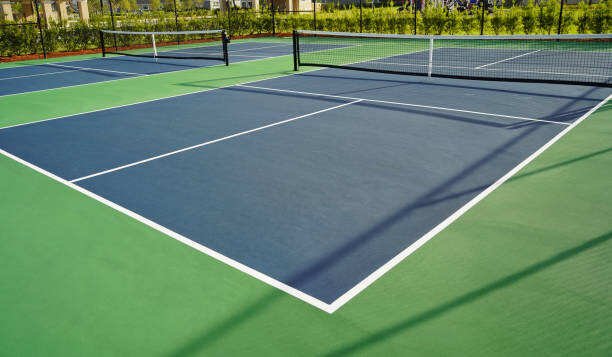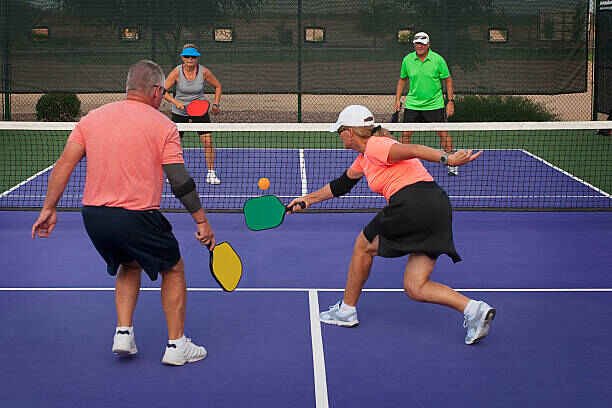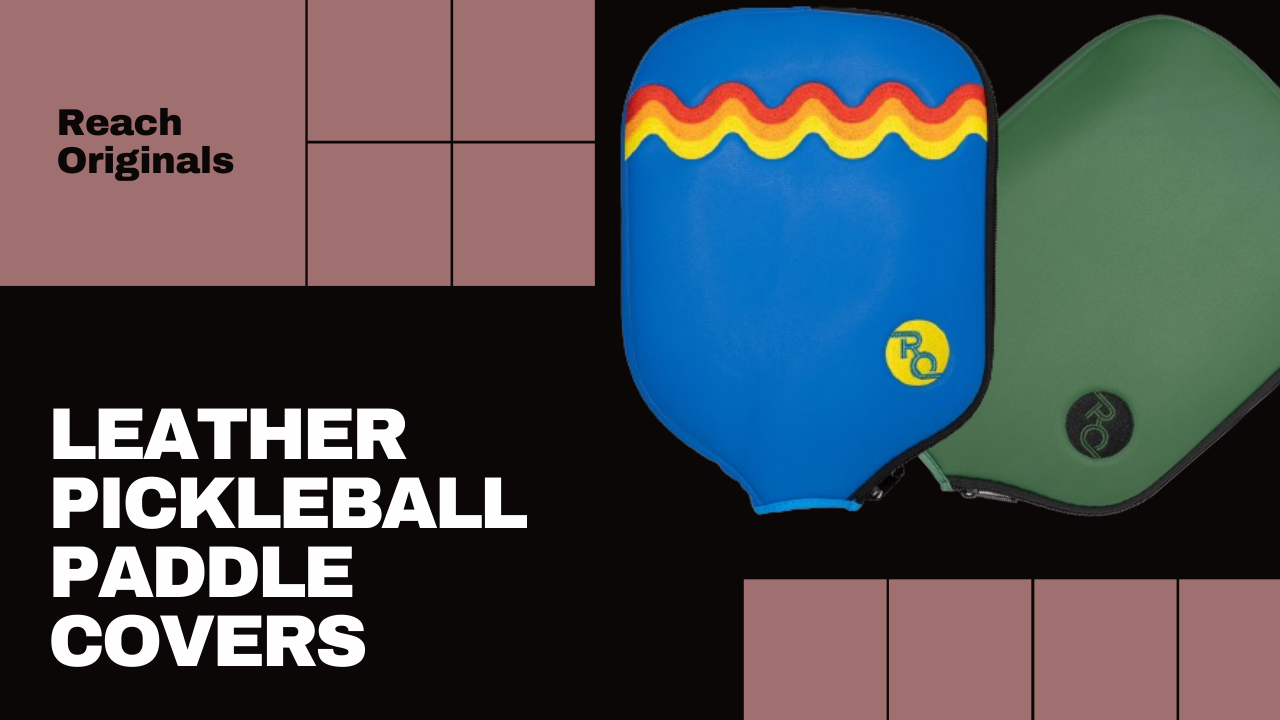It’s important to consider the spacing of the courts. This is necessary to create a space efficient and enjoyable environment for pickleball fans.
Perhaps you have often asked yourself how much space do you need between pickleball courts? This article will answer that question in its entirety.
So, here’s our dive into the topic!
How expensive is it to build a pickleball court?
Construction costs depend on several factors, including location, materials, and desired amenities. While the construction of a professional court can be a large investment, there are cost-effective options for those looking to create a pickleball space on a budget.
Materials, labor, and any additional features such as fencing or lighting are typically included in the cost of building a pickleball court. Court surfaces are typically asphalt or concrete, with asphalt being a more budget-friendly option. Fencing can be selected on the basis of durability and aesthetics, which is an additional cost consideration.
For those who are looking for a more economical solution, the DIY (Do It Yourself) construction of a pickleball court may be the right choice. Individuals can save on labor costs by handling aspects of the project themselves with proper research and planning. A satisfying and budget-friendly pickleball court project can be achieved by researching cost-effective materials and construction methods, while ensuring compliance with official pickleball court dimensions.
Terms of Picklebal Court
It is important for players and court builders to understand the terms associated with pickleball courts. Each term contributes to the overall dynamics of the game by referring to a specific area of the court.
Baseline
The baseline marks the outer boundary of the court at the end of the court, parallel to the net. Players serve from the back of the baseline, and shots that land outside of this line are considered to be out of bounds. Having a clear and well defined Baseline is essential for playing accurate and scoring fair.
Kitchen
The non-volleyball zone, commonly referred to as the “kitchen”, is the area immediately adjacent to the net on both sides of the court. Players are not allowed to serve a volley while standing in this area. In order to play strategically and follow the rules of the game, it is important to understand the dimensions and rules of the kitchen.
Center Line
The center line of the court is perpendicular to the net and divides the court into two equal halves. It serves as a point of reference for the players during the game, especially when determining the placement of the serve. The clearly marked center line helps to ensure fairness and accuracy in a pickball game.
Sidelines
The sidelines run parallel to the net on each side of the court and mark the boundaries of the side of the court. Shots that land outside of these lines are considered to be out of bounds. The accurate measurement and marking of the sidelines contributes to the integrity of the game by preventing disputes over the placement of the ball.
Service zone
The service zone is the area behind the baseline in which the players are required to stand when serving the ball. Serving diagonally across the net is a fundamental aspect of Pick Ball, and the service zone plays an important role in ensuring that proper serving technique is used and that the rules of the game are followed.
How Much Space Do You Need Between Pickleball Courts?
A minimum of 10 feet between pickleball courts is recommended.
In light of the importance of spacing between pickerball courts, it is important to have a closer look at the effects of proper spacing. In addition to preventing physical distractions, adequate spacing contributes to a positive playing environment. It minimizes distractions and creates a comfortable atmosphere for players.
Providing enough space between Pickerball courts is not just about following the guidelines; it directly affects the overall enjoyment of playing Pickerball. Without having to worry about stray balls or distractions from neighboring games, players can concentrate on their game. In busy or competitive environments where many games are played simultaneously, this consideration is especially important.
Spectator comfort and ease of movement is also provided by strategic court layout planning with relatively wide spacing between courts. Spectators can observe the game without being in the line of play, and players can freely navigate the area without disruption to nearby play. In essence, a key factor in creating a harmonious and well-organized pickleball facility is the distance between pickleball courts.
What are pickleball court dimensions?

Court dimensions are standardized to ensure a consistent and fair game. It is important for anyone involved in building or maintaining a pickleball court to understand these dimensions.
A standard pickleball court is 20 feet wide and 44 feet long. This includes the service and non-service areas. The net is in the center. The non-volley zone extends 7 feet on each side of the net. The baselines, sidelines, and center lines contribute to the overall dimensions of the court. This creates a well-defined playing area.
These dimensions apply to both indoor and outdoor Pickerball courts. However, adjustments can be made for recreational or residential areas where space may be limited. However, it is essential to maintain a proportional relationship between the various components of the court in order to maintain the integrity of the game.
How do I make an outdoor pickleball court?
Building an outdoor Pickerball court involves a number of steps. These steps ensure accuracy, durability and compliance with official standards. Each step contributes to the successful construction of an outdoor Pickerball court, from clearing the ground to applying the final surface.
Clear the Area
Begin by clearing the area you have designated of any debris, vegetation, or other obstructions. Ensure that the area is level and free of any possible obstacles. These initial steps lay the foundation for a smooth, well-prepared pickerball surface.
Mark the Court
An important step in the construction process is to accurately mark site dimensions. Mark break lines, base lines and other important components with measuring tools such as a long tape measure and chalk. Accurate marking helps ensure that the field conforms to code.
Tape the Lines
Use masking tape to create clear, defined lines after marking the field. The tape ensures that the final result is accurate and visually appealing, and serves as a temporary guide for the application of the pitch surface. Before proceeding, take time to double check your measurements and alignment.
Apply Picklepaver
Once you’ve taped your lines, it’s time to apply Pickle Paver, a surface coating designed specifically for Pickle Courts. This coating provides the texture and durability needed for optimal play. It is also weather resistant. Ensure the surface is even and smooth by following the manufacturer’s instructions for proper application. Before proceeding to the next step, allow adequate drying time.
Assemble the Net
It is time to install the net once the Picklepaver surface is dry. Most Pickleball courts use nets similar to those used in tennis, but with dimensions specific to Pickleball. Install a net pole in the center of each baseline and secure it. Assemble the net, making sure that it is connected and that it is at the correct height (36 inches on the edges of the court and 34 inches in the center). If necessary, adjust the tension of the net in accordance with local regulations.
Conclusion
The construction of an outdoor pickleball court is a systematic process to ensure accuracy, durability and compliance with official standards. From site cleaning to surface application, each step is important in creating a quality playing surface for pickerball fans.
Furthermore, understanding the importance of court spacings, crowd comfort, and adhering to standard dimensions is critical to creating a positive playing environment. Following court dimensions and spacing guidelines ensures safety, minimizes distractions, and promotes fair play.
Leave a comment below if you would like to share your recommendations for the next topic!



